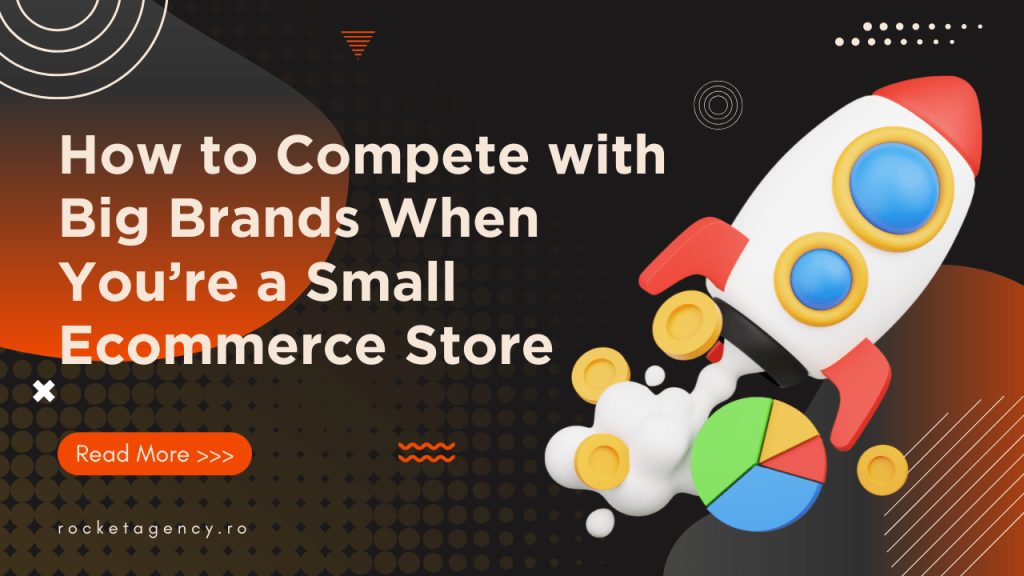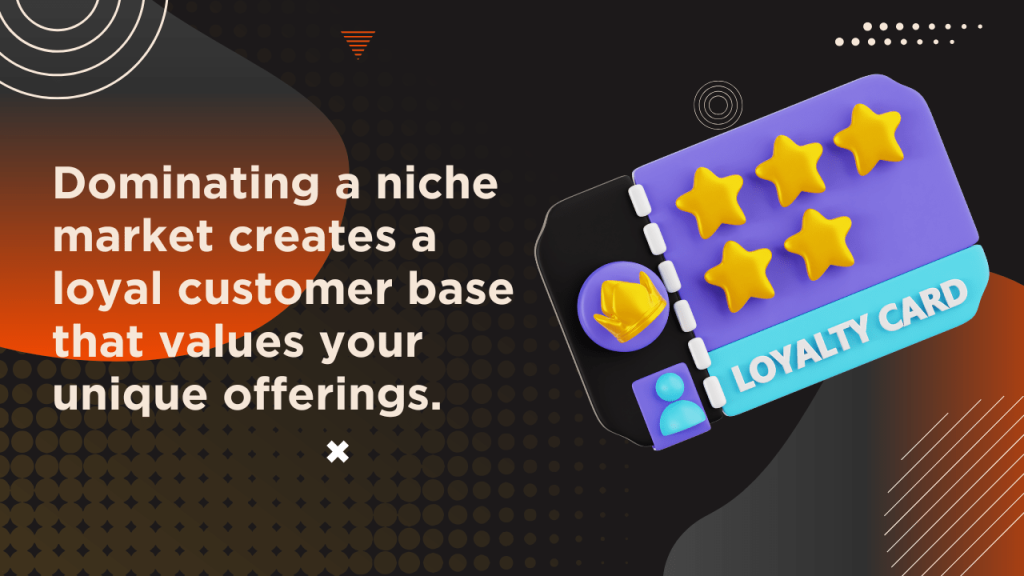
How to Compete with Big Brands When You’re a Small Ecommerce Store
Compete with big brands? If you’re a small ecommerce store owner, just hearing that phrase might raise your stress levels. It is frustrating to watch giant competitors dominate with huge marketing budgets, established name recognition, and endless resources. You might feel like David facing Goliath in the ecommerce arena. The pressure to keep up can be overwhelming – but take heart. There’s plenty of room online for savvy small businesses to thrive. With the right strategies, you can turn your size into an advantage and truly compete with big brands on your own terms.
Deliver an Outstanding User Experience (UX)
One area where you can immediately level the playing field is user experience. Large retailers like Amazon set a high bar for convenience – easy navigation, lightning-fast load times, and one-click purchasing. To compete, your website should be simple, fast, and customer-friendly. Use high-quality product photos and clear descriptions, make sure your site is mobile-responsive, and streamline the checkout process (no unnecessary forms or surprise fees). These steps reduce cart abandonment – an issue even big stores struggle with. In fact, nearly 70% of ecommerce shopping carts get abandoned on average, often due to friction in checkout. By offering a smooth, hassle-free purchase experience (including popular payment options like PayPal, which converts 28% higher than other methods, a small shop can match big-brand convenience and even win over shoppers who value an easier buying process.
Build a Unique Brand Identity and Story
Big corporations might have broader reach, but they often come off as faceless or impersonal. This is your chance to shine. Branding for a small ecommerce store should highlight what makes you different and authentic. Share your story – why did you start your business? What passion or mission drives you? When customers connect emotionally with your brand story, they see more than just a product; they see you. A compelling small-brand narrative can humanize your business in ways a giant corporation can’t easily emulate. For example, you can show behind-the-scenes peeks on social media, or write personal thank-you notes to customers – touches that make people feel valued. This human approach builds trust and loyalty. Stand for something meaningful (quality, sustainability, community, etc.) and weave it through your branding. A memorable, relatable brand identity gives customers a reason to choose you over a big-box competitor, helping you compete with big brands on more than just price.
Cultivate Customer Loyalty with Personal Touch
When you can’t out-spend the giants on acquiring new customers, focus on keeping your existing customers extremely happy. Customer loyalty is a small store’s secret weapon. Consider implementing a loyalty program or VIP club – for instance, point-based rewards, exclusive discounts for repeat buyers, or referral incentives. Loyal customers not only buy more over time, they also spread word-of-mouth and become brand advocates. This pays off hugely: Research shows that increasing customer retention by just 5% can boost profits by 25% to 95%. Why? Because retaining customers is far more cost-effective than constantly chasing new ones. As a small business, you can offer personalized customer service that big brands simply can’t match easily – remember details about regular customers, follow up to ensure they loved their purchase, and handle any issues with care and a human touch. When people feel genuinely cared for and appreciated (not just like order numbers in a system), they’re more likely to stick with you long term. Over time, a base of loyal, happy customers will help you compete with big brands by providing steady revenue and positive reviews that attract new shoppers.

Leverage Your Niche to Stand Out
Instead of trying to be everything to everyone, niche targeting lets you zero in on what you do best. Big brands aim to serve broad audiences, which means they often can’t cater deeply to specific niche interests or communities. You, however, can own a particular niche. Whether it’s a unique product category, a specific lifestyle audience, or an underserved market segment – specialize in it and become the go-to expert. For example, rather than a generic clothing store, you might focus on eco-friendly athletic wear or handmade toddler toys. By tailoring your products, content, and marketing to that niche, you build expertise and credibility that the big players lack. Niche specialization helps you compete with big brands by differentiating your store as the place that truly understands and serves that niche’s needs. Your marketing will also be more efficient because you’re speaking directly to your ideal customers’ passions. Over time, your niche audience will recognize your brand as the authority for that special corner of the market – and that loyalty and word-of-mouth can buffer you against larger competitors.
Niche Specialization Helps You Compete with Big Brands
Dominating a niche market creates a loyal customer base that values your unique offerings. Big corporations struggle to connect with niche audiences because they must appeal to the masses, but a small business can dive deep. Double down on what makes your product selection or expertise unique. Use content marketing (blog posts, videos, community forums) to reinforce your authority in that niche and attract like-minded customers. By being the best in a smaller field, you can thrive without directly head-to-head competing with a mega-retailer on every product. In short, owning your niche gives you a defensible space and reputation that helps you steadily compete with big brands without needing their scale.
Use Your Agility to Your Advantage
One of the greatest advantages of being a smaller ecommerce business is agility. Big enterprises have layers of bureaucracy – any change in strategy or product can take ages to implement. You, on the other hand, can pivot quickly and adapt to market trends or customer feedback in real time. Stay alert to what’s happening in your industry: new social media platforms, shifting consumer preferences, or emerging product trends. If a particular product isn’t selling, you can swiftly adjust your inventory or try a different offering next month. If you notice customers asking for a new feature, you can implement it without wading through corporate red tape. History has shown how deadly slow adaptation can be – just think of Blockbuster not reacting to the rise of streaming, which led to their. You don’t want to be the “Blockbuster” of your niche. Instead, embrace a test-and-learn mindset: experiment with a new marketing campaign, try out a pop-up shop or a limited-edition product, and see how customers respond. Being small means you can take these calculated risks without enormous costs. Your agility is a superpower – it lets you capitalize on opportunities or dodge threats faster than any big brand. By continuously improving and innovating in response to your customers, you’ll stay one step ahead and make it hard for slower-moving giants to catch up.
Personalize Your Email Marketing and Customer Touchpoints
One place where small ecommerce stores can often outshine big brands is personalized communication – especially via email marketing. Big companies send tons of automated, generic emails that often feel cold. You can do better by crafting emails that speak directly to your customers’ interests. Start by segmenting your email list (for example: by past purchases, preferences, or geographic location) and tailoring your messages to each group. Address customers by their name, and consider sending product recommendations based on what they bought before. These personal touches significantly boost engagement – for instance, 91% of consumers say they’re more likely to shop with brands that provide relevant, personalized offers. This means a well-personalized email campaign can directly translate into more sales and repeat business. Share useful content too, not just promotions: if you sell kitchenware, email a favorite recipe; if you sell outdoor gear, send a seasonal camping checklist. This positions your brand as a helpful friend rather than just a salesperson. The beauty of email marketing is its cost-effectiveness – you don’t need a big budget to send a heartfelt follow-up or a special discount to your top customers. Over time, these personalized interactions build stronger relationships and keep your audience coming back. In a world of spam and mass messaging, your thoughtful, tailored emails will help you compete with big brands by making customers feel truly seen and appreciated.
Maximize ROI with Efficient Performance Marketing
When it comes to paid advertising and promotions, a small ecommerce business cannot simply throw money around like a Fortune 500 company. But you can be smarter and more efficient with every marketing dollar – that’s the essence of performance marketing efficiency. Instead of broad, costly campaigns, focus on high-precision targeting. Modern ad platforms (Google, Facebook, etc.) let you aim ads at very specific demographics, interests, and even behaviors. Take the time to define your ideal audience and aim your ads exactly at them. For example, if you sell vegan skincare, you might target ads to users who follow vegan lifestyle pages or who recently searched for eco-friendly beauty products, rather than a general audience. This way, your budget is spent only on people likely to convert. Additionally, make use of re-marketing ads (showing ads to people who visited your site but didn’t buy) – these often have a high payoff for minimal cost.
Be sure to track your results and constantly refine. Run small A/B tests on your ad copy and imagery, measure the click-through rates and conversions, and then put more money into what works best. This iterative approach ensures you’re not wasting money on ineffective tactics. Also, consider channels beyond just ads: for instance, content marketing and SEO can drive organic traffic without the continual ad spend (it’s slower to grow but pays off in the long run). The key is to focus on return on investment (ROI) for each marketing effort. By squeezing more results from each dollar, you can compete with big brands even on a small budget. Remember, it’s not about the size of your budget, but how effectively you use it. A well-run, lean campaign that directly targets your customers’ needs can outperform a massive, unfocused campaign from a larger competitor.
Conclusion: Stay Scrappy and Leverage Your Strengths
At the end of the day, competing with the big guys comes down to leveraging the strengths of being small – your agility, personal touch, niche focus, and creativity – while also meeting customers’ expectations on things like website experience and service quality. You may not beat a big brand on sheer volume or advertising spend, but you can win on customer experience, authenticity, and value. Every time you delight a customer, respond to a feedback quickly, or introduce a cool new product that fills a gap, you’re doing something that a big corporation might struggle to do. Over time, these differences earn you a solid reputation.
Ready to compete with big brands? You don’t have to do it alone. Rocket Agency has helped many small and medium ecommerce businesses develop smart, tailored strategies to punch above their weight online. We understand the challenges you face and can work with you as a partner – from improving your site’s UX to optimizing your marketing campaigns for maximum impact. If you’re looking for practical support to grow your small ecommerce brand, reach out to Rocket Agency. With the right guidance and a determined mindset, your business can not only compete with big brands but thrive alongside them. Good luck, and remember: even Goliath can be beaten with the right strategy!
